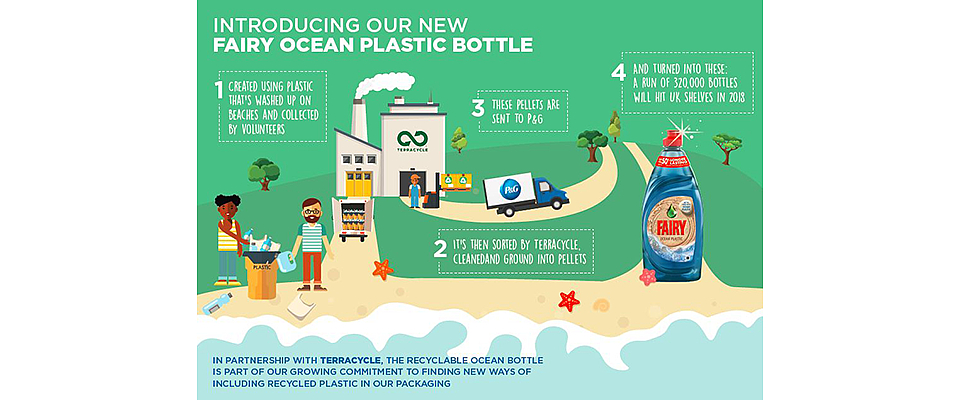- 320,000 Fairy Ocean Plastic bottles will be made, the largest production of its kind in the world.
- The Fairy Ocean Plastic Bottles, created in partnership with TerraCycle, will be available to buy in 2018 to raise awareness of ocean plastic pollution.
- The launch is part of P&G’s commitment to recycled plastic. P&G dish care brands divert 8,000 tonnes of plastic from landfill every year for use in transparent bottles.


Image: P&G
Circular economy
Procter & Gamble launches new Fairy Ocean Plastic bottle made from 100% recycled plastic and ocean plastic
The Procter & Gamble Company today launched the Fairy Ocean Plastic bottle made completely from post-consumer recycled (PCR) plastic and ocean plastic. The launch of the bottle aims to raise awareness of the issue of ocean plastic and what can be done to prevent plastic waste from reaching the ocean.

The Procter & Gamble Company today launched the Fairy Ocean Plastic bottle made completely from post-consumer recycled (PCR) plastic and ocean plastic. The launch of the bottle aims to raise awareness of the issue of ocean plastic and what can be done to prevent plastic waste from reaching the ocean.
The first-ever Fairy Ocean Plastic Bottle has been created in partnership with recycling expert TerraCycle and will reach British consumers in 2018. The UK launch will include 320,000 bottles, the largest production run of recyclable dish soap bottles in the world made using ocean plastic. The innovative bottle will be made from 10% ocean plastic, collected from the ocean and beaches around the world, and 90% post-consumer recycled plastic.
The project aims to drive awareness of the issue of ocean plastic pollution, inspire consumers to physically participate in beach clean-ups and recycle household waste.
Stemming the flow of plastic into the ocean is crucial to preserving the health of our ocean. According to the Ellen MacArthur Foundation (EMF) 95% of the value of plastic packaging material, worth $80-120 billion annually, is lost to the economy and on the current track, there could be more plastic than fish in the ocean (by weight) by 2050[1].
With the P&G Fairy Ocean Plastic bottle, and the intent to extend the initiative across other brands and regions in the future, P&G continues to leverage the power of its brands to inspire change. In an effort to divert plastic waste from landfill and the ocean, P&G brands, including Fairy, Dawn, Yes, Dreft and Joy, will continue to divert 8,000 metric tonnes of plastic from landfill for use in transparent plastic bottles, using an average of 40% Post-Consumer Recycled plastic content across 481 million of our transparent dish care bottles globally. If stacked, these bottles would be 11 times the height of Mount Everest.
Virginie Helias, Vice President of Global Sustainability at Procter & Gamble comments: “As the world’s no. 1 dishwashing liquid globally and a much-loved brand in the UK, we want to use Fairy to raise awareness about the plight of our ocean and raise awareness about the importance of recycling. Our consumers care deeply about this issue and by using ocean plastic we hope to show that the opportunities are endless when we rethink our approach to waste.’’
Tom Szaky, the CEO of TerraCycle: ‘’We are proud to be working with an iconic brand like Fairy to launch a fully recyclable bottle made from 100% recycled plastic and ocean plastic. The issue of ocean pollution is a pertinent one, we hope other brands will be inspired to think creatively about waste and make the circular economy a reality.’’
Susan Ruffo, Managing Director at Ocean Conservancy: ‘’We are thrilled that P&G is raising awareness of ocean plastic pollution amongst their consumers. P&G’s leadership on this issue, including through their participation in the Trash Free Seas Alliance, is critical to solving the ocean plastic crisis. We are excited that in addition to its work to reach consumers directly through the Fairy bottles, they are also addressing the source of ocean plastic by supporting our initiative to raise over $150 million over the next five years to improve waste collection, sorting and recycling in key ocean plastic economies. Improving waste management in these places can help cut the flow of plastic going into the ocean by half by 2025.”
[1] The Ellen MacArthur Foundation, The New Plastics Economy: Rethinking the future of plastics (2016), available at: https://www.ellenmacarthurfoundation.org/publications/the-new-plastics-economy-rethinking-the-future-of-plastics
The comPETence center provides your organisation with a dynamic, cost effective way to promote your products and services.

magazine
Find our premium articles, interviews, reports and more
in 3 issues in 2025.




